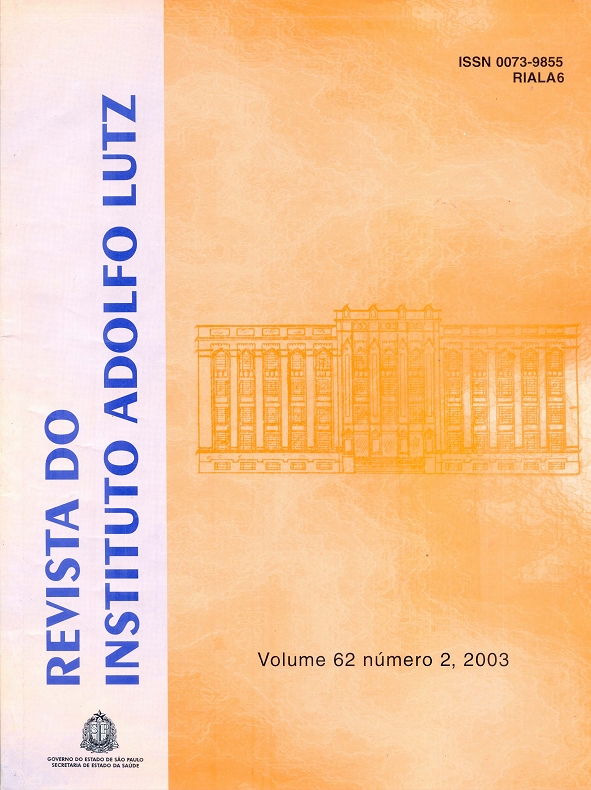Abstract
The use of pesticide in agriculture avoid the loss of foods but their residues may contaminated the environmental mainly the soil. This study proposed to evaluate the possible soil contamination by endosulfan and its principal metabolite, endosulfan sulphate. The experiment was carried out with soybean in area of 900m2 separated in three equal parts: control (without inseticide application), pests integrated management (PIM) and conventional systems, sprayed with 437g i.a./ha e 1312g i.a./ha, respectively. The endosulfan was quantified by gas chromatography with electron capture detector (Ni 63) seven days and one year after each spray. The endosulfan residues were not detected in the soil (10-20cm) cultivated with soybean in MIP system (10-20cm), within the limit of method uantification [α-endosulfan (0.005µg/g), β-endosulfan (0.005µg/g) e sulfato de endosulfan (0.1µg/g)]. The total endosulfan residue was 0.06µg/g to PIM in depth (0-10cm) and to conventional 0.14µg/g in (0-10cm) and 0.03µg/g in (10-20cm). After one year, none residue was detected in soil (0-20cm) for two systems. Both treatments were efficient to pests control, however PIM was suggested to use, because it result in low contamination level of soil by endosulfan.
References
1. Associação Brasileira das Indústrias de Óleos Vegetais – ABIOVE. http://www.abiove.com.br 1998.
2. Brasil. Ministério da Agricultura. Secretaria Nacional de Defesa Agropecuária. Portaria nº 95/85 de 21 de Novembro de 1985. Diário Oficial da União, 22 de Novembro de 1985.
3. Byers, R. A ., Woodham, D. W., Bowman, M. C. G. Residue on coastal Bermuda grass, trash and soil with endosulfan. Journal of the Econimc Entomology, 58: 160-161, 1965. Apud. World Health Organization. Endosulfan. Geneva: WHO, 1984. 60p. (Environmental Health Criteria, 40).
4. Costa, S. L. A soja na produção de alimentos. In: Seminário Nacional de Pesquisa de Soja, Londrina, 1978. Anais. Empresa Brasileira de Pesquisas Agropecuária, 1979. v.2, p.235-243.
5. Dores, E. F. G. C., De-Lamonica-Freire, E. M. Contaminação do ambiente aquático por pesticidas: vias de contaminação e dinâmica dos pesticidas no ambiente aquático. Pesticidas
Revista de Ecotoxicologia e Meio Ambiente, 9: p. 1-18, 1999.
6. Empresa Brasileira de Pesquisa Agropecuária. Recomendações técnicas para a cultura da soja na região Central do Brasil 1996/97. Londrina, 1996. 164 p.
7. Gelmini, G. A., Novo, J. P. S., Zamoriolli, D. P. Coletânea de portarias e informações gerais sobre defensivos agrícolas e receituário agronômico. 3a ed., Campinas: CATI, 1986. p. 159-161.
8. Goebel, H., Gorbach, S., Knauf, W., Rimpau, R.H., Hüttenbach, H. Properties, effects, residues, and analytics of the inseticide endosulfan. New York, Springer-Verlag, 1982. 174p. (Residues Reviews, 83).
9. Gorbach, S., Merz, H. D. Residue analysis of endosulfan in the soil of soybean field in Rio Grande do Sul. 1983, 8p. (não publicado).
10. Greve, P.A. Rapid identification method for endosulfan from GLC peak shifts under the influence of alkali. J. Agric. Food Chem., 19: 372, 1971.
11. Inomata, O. N. K.; Lemes, V. R. R.; Barreto, H. H. Avaliação dos teores de endosulfan em diferentes profundidades do solo. Rev. Inst. Adolfo Lutz, 56(2): 53-56, 1996.
12. Lehr, W. Statement concerning soil metabolism and mobility of endosulfan (Hoe 002671). Frankfurt, Hoechst, 1992a. 8p. (Report, PSR-WLO2/92).
13. Lehr, W. Statement concerning the hydrolysis and biodegradation of endosulfan in water. Frankfurt, Hoechst, 1992b. 8p. (Report, PSR-WLO5/92).
14. Lehr, W. Statement concerning the chemical classfication of endosulfan. Frankfurt, Hoechst, 1993. 3p. (Report, PSR-93/034).
15. Luke, M.A., Froberg, J.E., Masumoto, H.T. Extraction and clean-up of organochlorine, organophosphate, organonitrogen and hidrocarbon pesticides in produce for determination by gas-liquid chromatography. J. Assoc. Off. Anal. Chem., 58(5): 1020-1026, 1975.
16. Martens, R. Degradation of [8,9-14C]-endosulfan by microorganisms. Appl. Environ. Microbiol., 31: 853, 1976.
17. Miles, J. R. W., Harris, C. R. Journal Environ. Science Health Bulletin. V. 13, p. 199, 1978. Apud. MILES, J.R.W., MOY, P. Degradation of endosulfan and its metabolities by a mixed of sol culture of soil microorganism. Bull. Environ. Contam. Toxicol., 23: 13-19, 1979.
18. Miles, J.R.W., Moy, P. Degradation of endosulfan and its metabolities by a mixed of sol culture of soil microorganism. Bull. Environ. Contam. Toxicol., 23: 13-19, 1979.
19. Oliveira, J. J. V., Toledo, M. C. F. Resíduos de agrotóxicos em morangos. Pesticidas Revista Técnico Científica, 5: 95-110, 1995.
20. Racke, K. D. Pesticides in the soil microbial ecosystem. In: RACKE, Keneth D., COATS, Joel R. Enhanced biodegradation of pesticides in the environment. Iowa, Dow Elanco, 1990. 12p.
21. Raij, B. V.; Andrade, J. C.; Cantarella, H.; Quaggio, J. A. Análise química para avaliação da fertilidade de solos tropicais. Instituto Agronômico, Campinas, 2001, 285p.
22. Rao, D. M. R., Murty, A. S. Toxicity, biotransformation and elimination of endosulfan in Anabas testudineus (Bloch). Indian Journal of Experimental Biology, 18: 664-666, 1980.
23. Stumpf, K., Abhaver, J. An up-to-date review of the environmental chemistry of endosulfan. Frankfurt, Hoechst, 1986. 23p. (Report B 81/86).
24. Tornisielo, V. L., Pinho, R. S, Monteiro, R. T. R., Costa, M. A. Lixiviação do inseticida 14C-endosulfan em solos do Estado de São Paulo. Pesticidas Revista de Ecotoxicologia e Meio Ambiente, 8: 1-8, 1998.

This work is licensed under a Creative Commons Attribution 4.0 International License.
Copyright (c) 2003 Revista do Instituto Adolfo Lutz
